We photographers are always looking to save money and make more use of what we already have. Or at least we should be. Which is why teleconverters sound like such a great deal. For much less than the cost of a longer lens, you can give an existing lens more focal length. Want a big moon in your photo? You need a LOT of telephoto lens. However, there are often two problems with this. One, as with most things in life, you get what you pay for. And two, if teleconverters worked great all the time, why would anyone buy longer telephoto lenses? Oh yeah, and there’s that little issue that some teleconverters only work with certain lenses. Let’s go into more detail on all of this
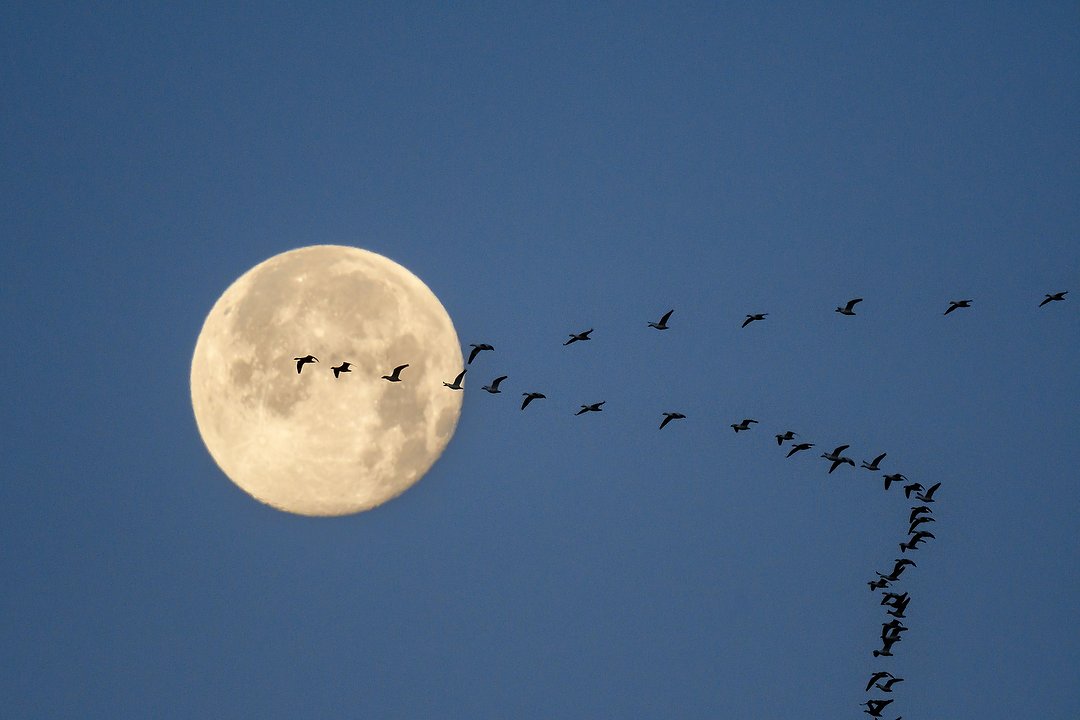
To get the moon large in this photo of snow geese before sunrise a few days ago, I paired a 500mm lens and 1.4 teleconverter, for 700mm focal length. Then I used an APS-C body for an added 1.5 crop factor, giving me an equivalent of 1050mm. Nikon D500, Aperture Priority, Sunny white balance, ISO 1800, 1/1250 at f/8 in Matrix metering, -0.7 EV, Nikkor AF-S Nikkor 500mm f/5.6E PF ED VR l with Nikkor TC-14e III teleconverter.
As a life-long Nikon shooter, I’ve been using their teleconverters since the early 2000’s. The two main ones I’ve had are the TC-14 and the TC-20 (Nikon does make others as well). The numbers correspond to the focal length increases, so 1.4X on a 200mm lens means 280mm. 2.0X on that same lens means 400mm. They’re able to add that focal length by having glass inside of them. However, that added glass, and increased distance to the sensor, mean a loss of light as well. 1.4X equals a one-stop loss, 2.0X a two-stop. That means a 70-200mm f/4 lens can now be a 280mm f/5.6 or a 400mm f/8, depending on the teleconverter used. At first blush, that sounds like a reasonable trade-off – a slower aperture for more “reach.” But are there any downsides other than a smaller f/stop? Yes.

These are the two Nikon teleconverters I use with my F-mount lenses, the TC14e III and TC20e III.
The reason most good teleconverters can’t be used with all lenses is that to get the best performance, the optics in a lens are developed for a specific focal length (or range of lengths with a zoom lens). So a one-size-fits-all approach to teleconverters is pretty much a recipe for poor performance. That explains why companies like Nikon make teleconverters that can only be used with specific lenses. That’s also why I’ve never seen a third-party (not made by the camera or lens manufacturer) teleconverter that produced sharp images. On my safari workshops, where our primary lenses are telephotos, I’ve had a few people bring third-party teleconverters to use with their lens. I’ve always suggested they use them sparingly the first day, then look at the results that night. Not one person has continued shooting with them after that. They simply didn’t produce sharp enough results. However, that doesn’t mean that a manufacturer’s teleconverter will produce sharp results.

My brown bear workshop in Alaska a few years ago is one of the many, many wildlife trips where that Nikkor 200-500 has been the perfect lens to bring, again paired with an APS-C body. However, I’ve had mixed results using teleconverters with it. More on that below. Nikon D500, Aperture Priority, Sunny white balance, ISO 320, 1/1000 at f/5.6 in Matrix metering, +0.7 EV, Nikkor 200-500mm f/5.6 lens at 500mm.
Sharpness is pretty easy to judge – you simply zoom in to 100% in your editing software and it should be obvious whether an image is sharp or not. If it’s not, then you need to do some detective work, looking at shutter speed and focus, to make sure it’s not something else affecting sharpness. That’s why whenever I hear someone say, “this lens just isn’t sharp,” I always suggest they do a series of tests, often involving a tripod, to confirm whether that’s true or not. And the same should be done with a teleconverter.
Autofocus speed is the other thing you should be paying attention to. Most people don’t realize it, but aperture plays a big role in that. The more light entering the lens, the faster the AF can perform (of course, the camera plays a big role in this as well). That means an f/2.8 lens will focus faster than an f/4, which will be faster than an f/5.6, etc. And, in fact, once you get down to f/8 and smaller, some AF systems simply don’t perform well, if at all. So adding a teleconverter will affect AF speed.
In my experience, good 1.4X teleconverters, used properly, should result in very good sharpness. I have no complaints about my Nikon 1.4X teleconverters for their F-mount lenses. With longer teleconverters, however, I’ve almost always seen a slight drop in sharpness at long distances. In other words, I’ve found my Nikon 2X teleconverters very sharp up to 50-75 yards, but after that have seen a slight loss. But again, we know there are often trade-offs in life. I’m willing to accept that in order to make my 500mm f/4 Nikkor lens a 1000mm f/8 for a few hundred dollars. It’s also important to point out that with that kind of magnification, I try to use a tripod whenever possible. The slightest camera movement, as well as dust, haze, etc. can also have a big effect on sharpness. That’s the rig I used to photograph polar bears in the Arctic a few years ago, which allowed me to make high-quality close-up photos from a safe distance.
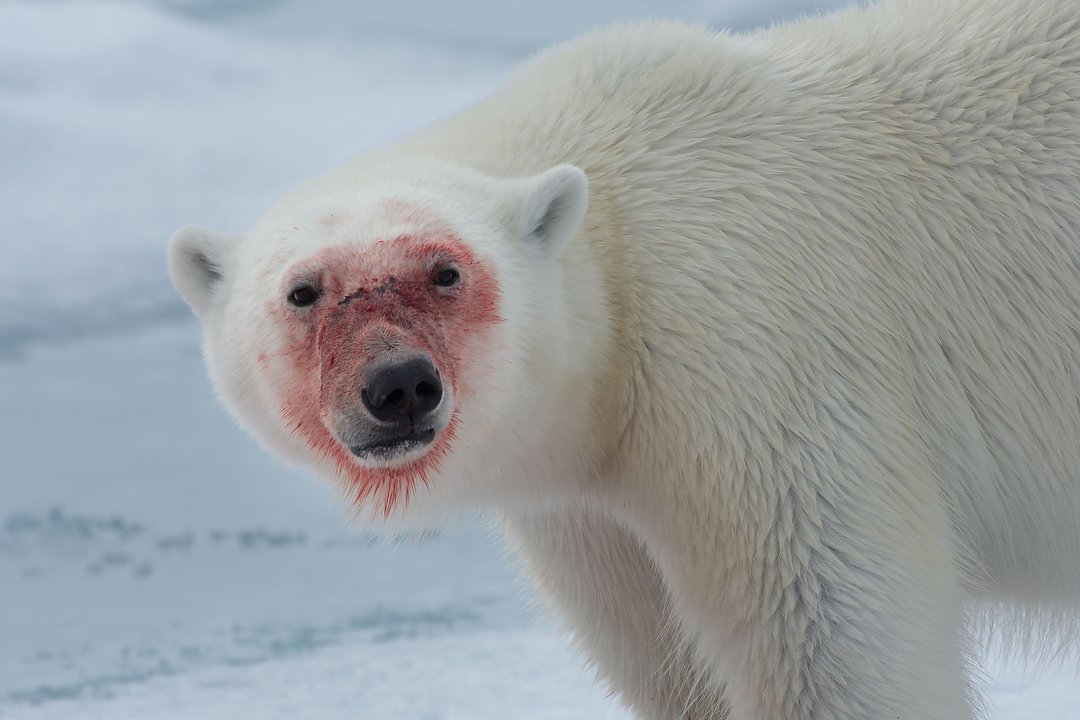
Photographing polar bears in the wild, for a close-up, you want as much lens as possible. This is the full-frame image, shot from a tripod on the deck of our ship, which was parked in the ice. Nikon D7200, Aperture priority, ISO 500, 1/1600 at f/8, EV 0.0, Nikkor 500mm f/4 lens with TC20 teleconverter for 1000mm. Shooting on a DX camera, that gave me an equivalent focal length of 1500mm. I don’t generally recommend using a tripod on a ship, but between the ship being still and the massive amount of telephoto I was using, it was a good decision.
Not surprisingly, the lens you’re using a good teleconverter with can make a big difference, too. I love my Nikkor 200-500mm f/5.6 lens, have taken it to Africa several times now, and paired with an APS-C body (D500 in my case) is an awesome wildlife lens. It’s sharp, wide open. However, I’ve had mixed results using it with my Nikon 1.4X teleconverter. A little Autofocus Fine Tuning has helped, but it’s still doesn’t always give me the sharpness I want. Which is why I sprung for Nikon’s 500mm f/5.6 PF lens recently. I already have a 500mm f/4, and the 200-500mm f/5.6, so adding the 500mm f/5.6 was a luxury purchase. But, it’s smaller and lighter than either of those, and more importantly, is very, very sharp when paired with Nikon’s current-generation 1.4 teleconverter (the TC-14e III). Here’s a recent story I did about that, and some photos from yesterday, too:

I was incredibly lucky (though this duck wasn’t) on my first outing to test my new Nikon 500mm f/5.6 PF lens with 1.4X teleconverter at a nearby park. Nikon D500, Aperture Priority, Sunny white balance, ISO 250, 1/800 at f/8 in Matrix metering, 0.0 EV. Photo copyright Reed Hoffmann.
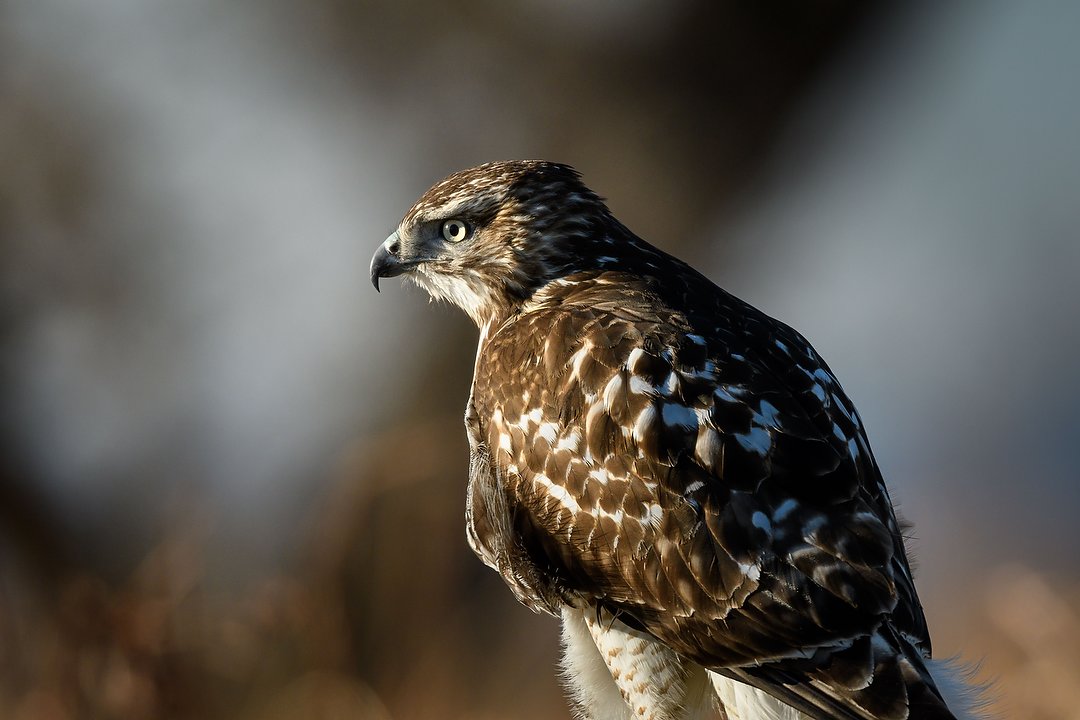
I’m rarely able to get close to hawks, but Monday this one stayed perched on the post fpr a few minutes as I stayed in my car. This is also the full-frame image. Nikon D500, Aperture Priority, Sunny white balance, ISO 1000, 1/2000 at f/8 in Matrix metering, 0.0 EV, Nikkor AF-S Nikkor 500mm f/5.6E PF ED VR lens with Nikkor TC-14e III teleconverter for 700mm. Photo copyright Reed Hoffmann.
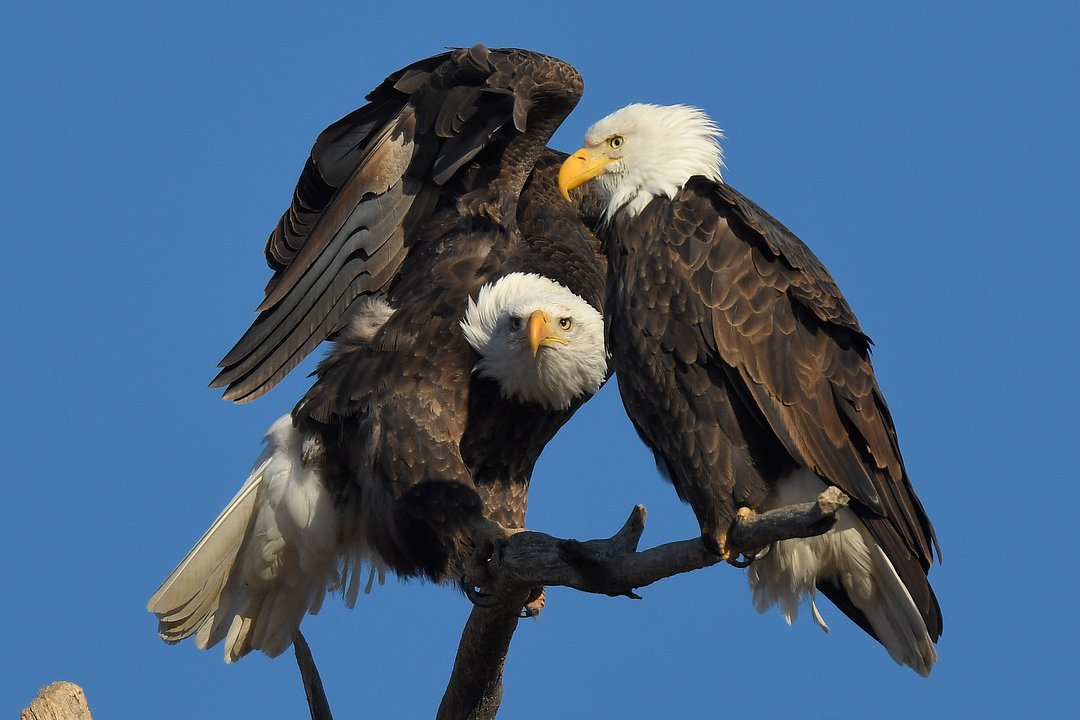
Monday morning I found this pair of eagles in a great spot, not too far away and not blocked by branches. With the light weight of the 500mm PF lens, I was able to shoot hand-held. Nikon D500, Aperture Priority, Sunny white balance, ISO 450, 1/1600 at f/8 in Matrx metering, 0.0 EV, Nikkor AF-S Nikkor 500mm f/5.6E PF ED VR lens with Nikkor TC-14e III teleconverter for 700mm. Photo copyright Reed Hoffmann.

Here’s a screenshot from my monitor at 100%, so you can see the amount of sharpness and detail I get with that combination.
When Nikon introduced their Z cameras, they also introduced the world to the widest lens mount for that type of camera (Canon’s is the next widest, followed by Sony’s). They made a big deal about what they could do optically because of that mount, and as their Z lenses have come out, that promise seems to be holding true. So when I bought my Z series 70-200mm f/2.8, what I really wanted to do was test it with Nikon’s new Z series 2X teleconverter (and no, the Z teleconverters can’t be used with Nikon’s F-mount lenses). I had that opportunity in November, when two of my clients at the Moab workshop brought that combination. I borrowed that lens and teleconverter to shoot some tests with, and was blown away. I’ve never seen that kind of sharpness, at distance, from a 2X teleconverter. Not surprisingly, that performance comes at a premium price (about $600 retail for the teleconverter). But a lesson I’ve learned over and over, particularly in this business, is you get what you pay for (hopefully!). So last week I bought my own, and took it, along with the Z 70-200mmm f/2.8 lens and Z 6 II to do some bird photography. The results were just what I expected, excellent.
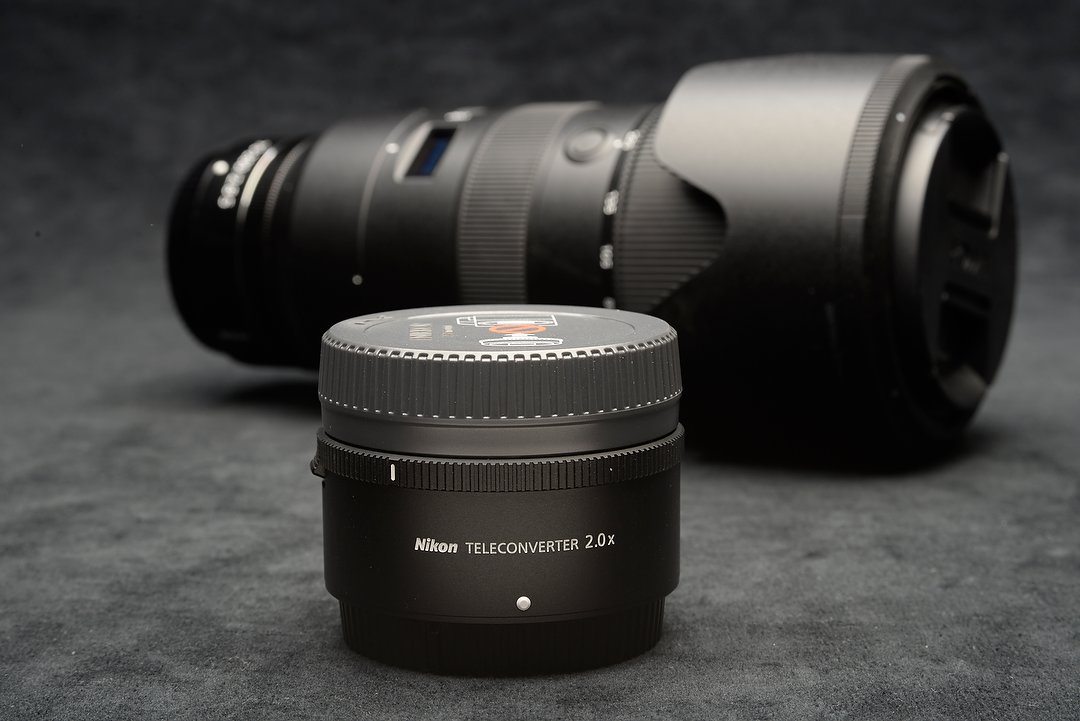
Here’s my new Nikon TC 20 Z-series teleconverter, and paired with my Z-series 70-200mm /f2.8 (behind), I’ve now got a very sharp 140-400mm f/5.6 lens.

This was shot Monday as well, using the 70-200 f/2.8 lens and new Z TC20 teleconverter, for 400mm. Look at the screenshot below to see how incredibly sharp this combination is, even at a long distance and wide open. Nikon Z II, Aperture Priority, Sunny white balance, ISO 320, 1/2000 at f/5.6 in Matrix metering, 0.0 EV.

Here’s that screenshot at 100%. Note how much detail there is even in the webbed feet of the duck near the center.
Is a teleconverter right for you? As with most photography questions, the answer is, “it depends.” Depends on the lense(es) you have, who they’re made by, how old or new they are, and how critical you are of sharpness. And if you’d like to do some testing of your own, I’d suggest you rent first, from a local dealer if they offer that service, or from BorrowLenses.com or LensRentals.com. Who knows, perhaps a good teleconverter will let you take your wildlife photography to a new level. It will certainly get you closer!
– Interested in learning more about how I research and do Wildlife photography? Check out the live, online classes I teach, at this link –
(If you like this story, please share it with your friends and let them know about the links on photography that I post on my business Facebook page. I’m also on Instagram and Twitter, @reedhoffmann. And if you’re curious about the workshops I teach, you can find them here. And, you can subscribe to this blog on my home page.)
We photographers are always looking to save money and make more use of what we already have. Or at least we should be. Which is why teleconverters sound like such a great deal. For much less than the cost of a longer lens, you can give an existing lens more focal length. Want a big moon in your photo? You need a LOT of telephoto lens. However, there are often two problems with this. One, as with most things in life, you get what you pay for. And two, if teleconverters worked great all the time, why would anyone buy longer telephoto lenses? Oh yeah, and there’s that little issue that some teleconverters only work with certain lenses. Let’s go into more detail on all of this

To get the moon large in this photo of snow geese before sunrise a few days ago, I paired a 500mm lens and 1.4 teleconverter, for 700mm focal length. Then I used an APS-C body for an added 1.5 crop factor, giving me an equivalent of 1050mm. Nikon D500, Aperture Priority, Sunny white balance, ISO 1800, 1/1250 at f/8 in Matrix metering, -0.7 EV, Nikkor AF-S Nikkor 500mm f/5.6E PF ED VR l with Nikkor TC-14e III teleconverter.
As a life-long Nikon shooter, I’ve been using their teleconverters since the early 2000’s. The two main ones I’ve had are the TC-14 and the TC-20 (Nikon does make others as well). The numbers correspond to the focal length increases, so 1.4X on a 200mm lens means 280mm. 2.0X on that same lens means 400mm. They’re able to add that focal length by having glass inside of them. However, that added glass, and increased distance to the sensor, mean a loss of light as well. 1.4X equals a one-stop loss, 2.0X a two-stop. That means a 70-200mm f/4 lens can now be a 280mm f/5.6 or a 400mm f/8, depending on the teleconverter used. At first blush, that sounds like a reasonable trade-off – a slower aperture for more “reach.” But are there any downsides other than a smaller f/stop? Yes.

These are the two Nikon teleconverters I use with my F-mount lenses, the TC14e III and TC20e III.
The reason most good teleconverters can’t be used with all lenses is that to get the best performance, the optics in a lens are developed for a specific focal length (or range of lengths with a zoom lens). So a one-size-fits-all approach to teleconverters is pretty much a recipe for poor performance. That explains why companies like Nikon make teleconverters that can only be used with specific lenses. That’s also why I’ve never seen a third-party (not the camera or lense’s manufacturer) teleconverter that produced sharp images. On my safari workshops, where we primarily use telephoto lenses, I’ve had a few people bring third-party teleconverters to use with their telephoto lens. I’ve always suggested they use them sparingly the first day, then look at the results that night. Not one person has continued shooting with them after that. They simply didn’t produce sharp results. However, that doesn’t mean that a manufacturer’s teleconverter will produce sharp results.

My brown bear workshop in Alaska a few years ago is one of the many, many wildlife trips where that Nikkor 200-500 has been the perfect lens to bring, again paired with an APS-C body. Nikon D500, Aperture Priority, Sunny white balance, ISO 320, 1/1000 at f/5.6 in Matrix metering, +0.7 EV, Nikkor 200-500mm f/5.6 lens at 500mm.
Sharpness is pretty easy to judge – you simply zoom in to 100% in your editing software and it should be obvious if an image is sharp or not. If it’s not, then you need to do some detective work, looking at shutter speed and focus, to make sure it’s not something else affecting sharpness. That’s why whenever I hear someone say, “this lens just isn’t sharp,” I always suggest they do a series of tests, often involving a tripod, to confirm whether that’s true or not. And the same should be done with a teleconverter.
Autofocus speed is the other thing you should be paying attention to. Most people don’t realize it, but aperture plays a big role in that. The more light entering the lens, the faster the AF can perform (of course, the camera plays a big role in this as well). That means an f/2.8 lens will focus faster than an f/4, which will be faster than an f/5.6, etc. And, in fact, once you get down to f/8 and smaller, some AF systems simply don’t perform well, if at all. So adding a teleconverter will affect AF speed.
In my experience, good 1.4X teleconverters, used properly, should result in very good sharpness. I have no complaints about my Nikon 1.4X teleconverters for their F-mount lenses. With longer teleconverters, however, I’ve almost always seen a slight drop in sharpness at long distances. In other words, I’ve found my Nikon 2X teleconverters very sharp up to 50-75 yards, but after that have seen a slight loss. But again, we know there are usually trade-offs in life. I’m willing to accept that to make, say, my 500mm f/4 Nikkor lens a 1000mm f/8 for a few hundred dollars and carry a relatively small accessory. It’s also important to point out that with that kind of magnification, I try to use a tripod whenever possible. The slightest camera movement, as well as dust, haze, etc. can also have a big effect on sharpness. That’s the rig I used to photograph polar bears in the Arctic a few years ago, which allowed me to make high-quality close-up photos from a safe distance.

Photographing polar bears in the wild, you usually want as much lens as possible. This is the full-frame image, shot from a tripod on the deck of our ship, which was parked in the ice. Nikon D7200, Aperture priority, ISO 500, 1/1600 at f/8, EV 0.0, Nikkor 500mm f/4 lens with TC20 teleconverter for 1000mm. Shooting on a DX camera, that gave me an equivalent focal length of 1500mm. I don’t generally recommend using a tripod on a ship, but between the ship being still and the massive amount of telephoto I was using, it was a good decision.
Not surprisingly, the lens you’re using a good teleconverter with can make a big difference, too. I love my Nikkor 200-500mm f/5.6 lens, have taken it to Africa several times now, and paired with an APS-C body (D500 in my case) is an awesome wildlife lens. It’s sharp, wide open. However, I’ve had mixed results using it with my Nikon 1.4X teleconverter. A little Autofocus Fine Tuning has helped, but it’s still doesn’t always give me the sharpness I want. Which is why I sprung for Nikon’s 500mm f/5.6 PF lens recently. I already have a 500mm f/4, and the 200-500mm f/5.6, so adding the 500mm f/5.6 was a bit of overkill. However, it’s smaller and lighter than either of those, but more importantly, is very, very sharp when paired with Nikon’s current-generation 1.4 teleconverter (the TC-14e III). Here’s a recent story I did about that, and some photos from this week too:

I was incredibly lucky (though this duck wasn’t) on my first outing to test the Nikon 500mm f/5.6 PF lens with 1.4X teleconverter at a nearby park. Nikon D500, Aperture Priority, Sunny white balance, ISO 250, 1/800 at f/8 in Matrix metering, 0.0 EV. Photo copyright Reed Hoffmann.

I’m rarely able to get close to hawks, but Monday this one stayed perched on the post as long as I stayed in my car. This too is the full-frame image. Nikon D500, Aperture Priority, Sunny white balance, ISO 1000, 1/2000 at f/8 in Matrix metering, 0.0 EV, Nikkor AF-S Nikkor 500mm f/5.6E PF ED VR lens with Nikkor TC-14e III teleconverter for 700mm. Photo copyright Reed Hoffmann.

Monday morning I found this pair of eagles in a great spot, not too far away and not blocked by branches. With the lightweight of the 500mm PF lens, I was able to shoot hand-held. Nikon D500, Aperture Priority, Sunny white balance, ISO 450, 1/1600 at f/8 in Matrx metering, 0.0 EV, Nikkor AF-S Nikkor 500mm f/5.6E PF ED VR lens with Nikkor TC-14e III teleconverter for 700mm. Photo copyright Reed Hoffmann.
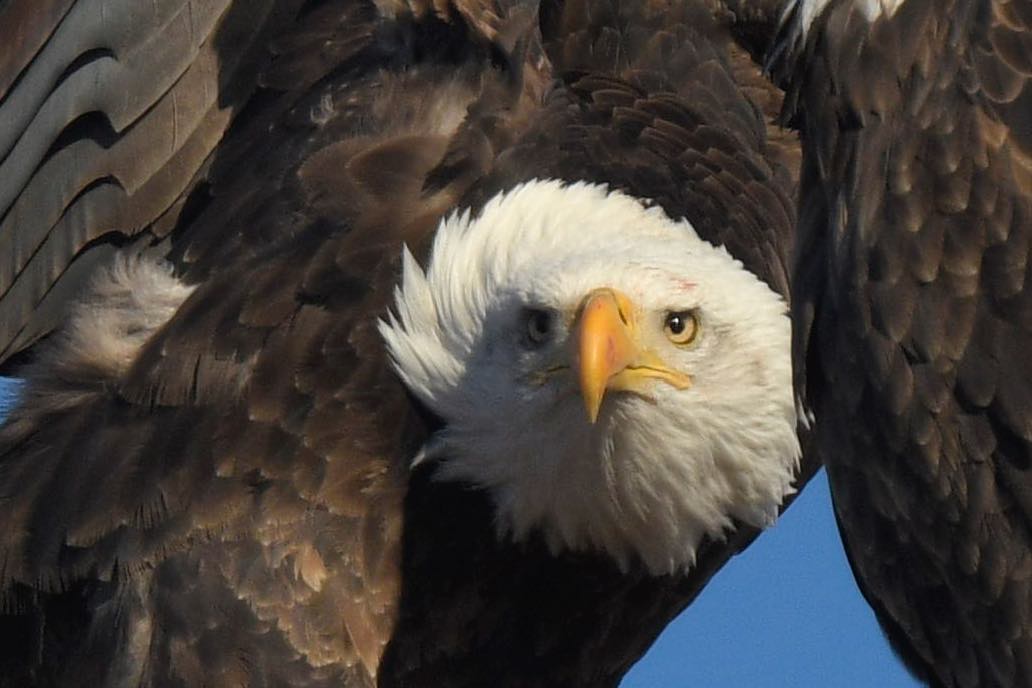
Here’s a screenshot from my monitor at 100%, so you can see the amount of sharpness and detail I get with that combination.
When Nikon introduced their Z cameras, they also introduced the world to the widest lens mount for that type of camera (Canon’s is the next widest, followed by Sony’s). They made a big deal about what they could do optically because of that mount, and as their Z lenses have come out, that promise seems to be holding true. So when I bought my Z series 70-200mm f/2.8, what I really wanted to do was test it with Nikon’s new Z series 2X teleconverter (and no, the Z teleconverters can’t be used with Nikon’s F-mount lenses). I had that opportunity in November, when two of my clients at the Moab workshop brought that combination. I borrowed that lens and teleconverter to shoot some tests with, and was blown away. I’ve never seen that kind of sharpness, at distance, from a 2X teleconverter. Not surprisingly, that performance comes at a premium price (about $600 retail for the teleconverter). But a lesson I’ve learned over and over, particularly in this business, is you get what you pay for. So last week I bought my own, and took it, along with the Z 70-200mmm f/2.8 lens and Z 6 II to do some bird photography. The results were just what I expect, excellent.

Here’s my new Nikon TC 20 Z-series teleconverter, and paired with my Z-series 70-200mm /f2.8 (behind), I’ve now got a very sharp 140-400mm f/5.6 lens.

This was shot Monday as well, using the 70-200 f/2.8 lens and new Z TC20 teleconverter, for 400mm. Look at the screenshot below to see how incredibly sharp this combination is, even at a long distance and wide open. Nikon Z II, Aperture Priority, Sunny white balance, ISO 320, 1/2000 at f/5.6 in Matrix metering, 0.0 EV.
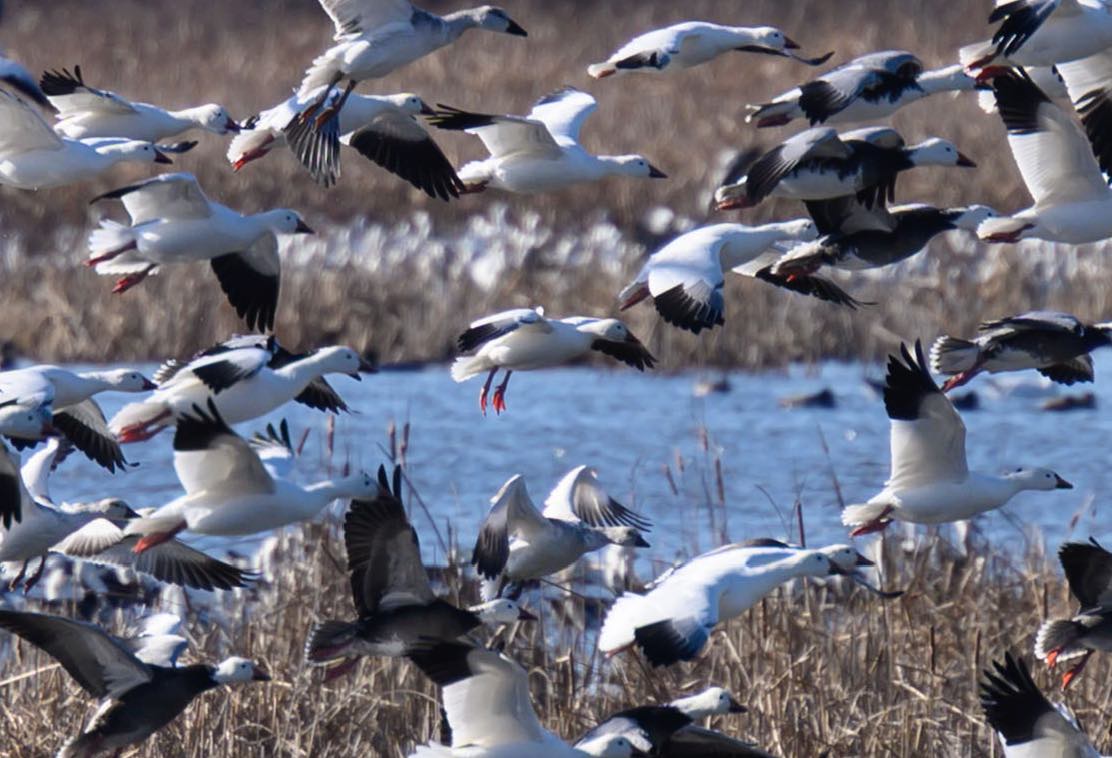
Here’s a screenshot at 100%. Note how much detail there is even in the webbed feet of the duck near the center.
Is a teleconverter right for you? As with most photography questions, the answer is, “it depends.” Depends on the lense(es) you have, who they’re made by, how old or new they are, and how critical you are of sharpness. And if you’d like to do some testing of your own, I’d suggest you rent first, from a local dealer if they offer that service, or from BorrowLenses.com or LensRentals.com. Who knows, perhaps a good teleconverter will let you take your wildlife photography to another level.
– Interested in learning more about how I research and do Wildlife and/or Night photography? Check out the live, online classes I teach, at this link –
(If you like this story, please share it with your friends and let them know about the links on photography that I post on my business Facebook page. I’m also on Instagram and Twitter, @reedhoffmann. And if you’re curious about the workshops I teach, you can find them here. And, you can subscribe to this blog on my home page.)

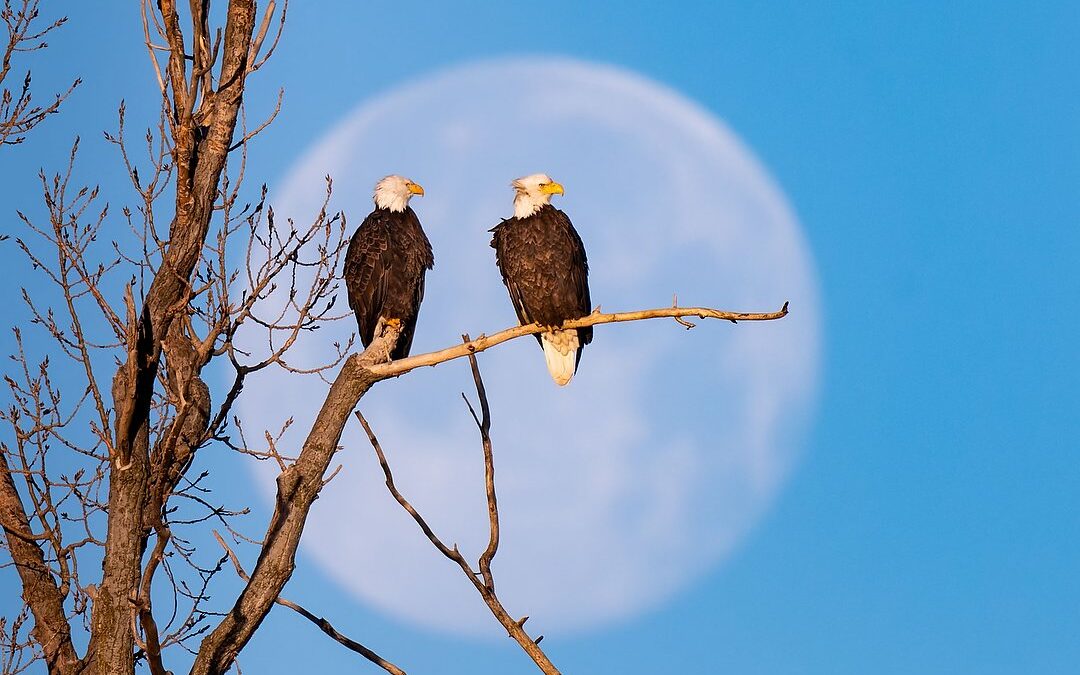
Thanks Reed. Great story & images!